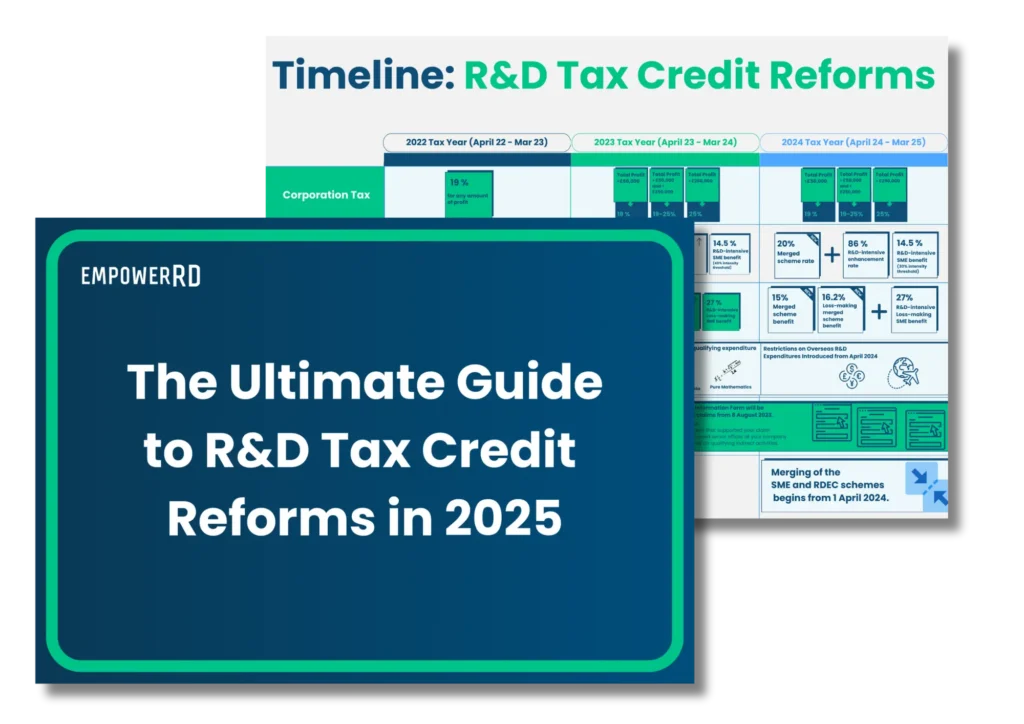Beginning 1 April 2024, all UK companies face restrictions on claiming R&D tax credits for overseas contractors, a significant shift affecting numerous innovative businesses.
You only need to look at our latest survey of 300 founders and finance leads to see the full effect this change is likely to have—it reveals that nearly 50% of tech companies are allocating 20% or more of their R&D spend to overseas contractors.
It isn’t a surprise that the government has implemented this reform, the R&D tax relief scheme is designed to promote innovation within the UK, and the inclusion of overseas R&D as a qualifying expenditure goes against this aim.
Whilst the thinking behind this move is clear, it doesn’t stop it from being a significant challenge for companies that claim R&D tax relief. They will have to navigate this transition, assessing the benefits of tax incentives against the difficulties of resource costs, and securing the right talent.
The cost of resources and overseas employment
With the impending changes to overseas R&D expected to affect the claims of many innovative companies beginning 1 April 2024, UK tech companies face a critical decision about their employment strategies.
For years, companies have been encouraged to hire talent from overseas. This approach not only grants businesses access to a broader global talent pool but also offers them modest financial advantages, including the ability to claim tax relief on the overseas R&D conducted. Nonetheless, this strategy now requires reevaluation.
Does the value of selecting overseas talent outweigh the reduced R&D tax relief you’ll be able to claim for UK talent?
To thoroughly explore this question, we analysed mid-level software developer salaries globally. The incentive to claim tax relief on overseas R&D expenses has long motivated businesses to search globally for software development talent, expanding the talent pool and allowing for more efficient financial management.
Despite the UK’s competitive average software developer salary of £45,000, France and Germany offer viable alternatives with average salaries of £51,440 and £47,155 respectively, especially with tax relief incentives, making it financially viable to recruit talent from areas with higher living costs.
Countries with moderate living costs, like Spain and Portugal, where salaries are around £34,295, have become increasingly appealing due to R&D tax relief. Eastern Europe, particularly Poland with an attractive average salary of £25,720, emerged as a financially viable region for UK companies, thanks to tax benefits.
However, with the reform, this scenario is set to change significantly. The financial appeal of sourcing talent from Western Europe is expected to diminish, making countries like Portugal and Spain almost as financially appealing as the UK after tax relief. For example, a loss-making, R&D-intensive SME could see the effective net salary of an average software developer in the UK, post-tax relief, drop to around £34,672—yielding savings of over £10,000. This shift narrows the scope for getting cost-effective talent.
Moreover, the reforms make hiring from the Americas less financially appealing. The average salaries in Brazil and Mexico, at around £49,296, become less competitive compared to the UK once tax relief is factored in.
Despite this, Poland’s affordable average salary continues to stand out, though concerns about the availability of specialised talent remain.
Asia offers a cost-effective alternative, with average salaries in countries like China and Vietnam at £24,648. However, operational challenges such as communication barriers, time zone differences, and collaboration hurdles may reduce the attractiveness of cost savings.
Ultimately, the overhaul of R&D tax relief criteria prompts UK tech companies to thoroughly reexamine their global talent sourcing strategies. This necessitates a deeper analysis of cost efficiency versus operational effectiveness, shifting the strategic focus towards a mix of local and international talent to drive innovation and growth.
Sources:
TalentUp. (2023). Overview of Developer Salaries in Europe. Retrieved from https://talentup.io/blog/developer-salaries-in-europe/“
Insider Monkey. (2023). 15 Countries With the Lowest Rates of Software Developers. Retrieved from https://www.insidermonkey.com/blog/15-countries-with-the-lowest-rates-of-software-developers-660793/
The state of local talent in light of R&D tax relief changes
As the tech sector prepares for the forthcoming reforms in R&D tax relief, it is anticipated that more companies are likely to turn their focus towards domestic talent. This raises an important question: what is the current status of the UK’s talent pool, and is it substantial enough to help businesses navigate the potential challenges posed by the reform affecting overseas R&D contractors?
The latest UK Innovation Report 2024 by the Cambridge Industrial Innovation Policy presents a nuanced picture, highlighting both strengths and challenges within the nation’s tech sector. On one hand, the UK boasts an impressive number of STEM graduates, with 42% of all graduates in the 2021/22 academic year hailing from STEM fields.
On the other hand, the tech sector faces a critical STEM skills gap, with a 6.9% shortfall in digital skills among the workforce. This gap reveals a stark mismatch between the pool of available talent and the growing needs of the industry, underscoring the complex paradox at the heart of the UK’s tech sector.
Strategic implications for R&D tax relief changes
The forthcoming reforms present both a challenge and an opportunity for businesses. By offering R&D tax relief as an incentive for local hiring, these changes encourage UK tech companies to tap into the domestic talent pool.
This strategy requires a holistic approach to talent development, highlighting the need to meet current hiring requirements and develop a robust pipeline of professionals skilled in digital technologies, helping to bridge the existing skills gap.
How can we nurture this moving forward?
-
- Education-industry partnerships: Strengthening collaborations between tech firms and educational institutions is vital. These partnerships can help tailor curriculums to meet the IT sector’s needs better, ensuring students graduate with the most sought-after digital skills.
-
- Upskilling and reskilling efforts: Companies must boost investment in training programmes for current employees. These initiatives allow firms to develop the advanced digital competencies required to remain competitive, from cloud computing expertise to AI and machine learning proficiency.
-
- Innovative recruitment strategies: Tech companies should explore new methods of bringing in talent beyond traditional approaches. This includes apprenticeship schemes for young tech enthusiasts and career transition opportunities for professionals from other sectors, leveraging transferable skills to diversify the talent pool.
The new R&D tax relief regulations are timely for the UK’s IT sector amidst a digital skills shortage. While posing challenges, they prompt a review of talent development. By enhancing domestic digital skills, UK tech firms can navigate tax relief changes and foster long-term innovation and growth. Investing in local digital skills not only closes the gap but also positions the UK as a global IT leader, driving technological advancements.
Navigating visa and sponsorship challenges
We’ve established that the UK is grappling with a shortage in information and technology skills, marked by a 6.9% digital competency gap within its workforce. To get around this shortfall, UK tech companies can use visa options such as the Skilled Worker Visa and the Global Talent Visa, attracting international talent. These visas not only address the immediate skill shortages but also contribute to the long-term development of the UK’s tech talent pool.
But what exactly are these two visa options?
Skilled Worker Visa
The Skilled Worker Visa caters to individuals who have secured a job offer in an eligible role from a UK employer and satisfy the minimum salary threshold, which stands at £26,200 for most roles and may be lower for certain shortage occupations.
For Employers:
-
- Costs involve a sponsor licence fee of £536 for small entities per year and £1,476 for larger companies, with an additional £239 per sponsorship certificate and an Immigration Skills Charge of approximately £6,715 over five years for each employee in a large firm (£1,343 per year)
For Job Seekers:
-
- Visa fees range between £719 and £1,420, alongside a yearly healthcare surcharge of £624, potentially increasing to £1,035. Applicants must also demonstrate financial solvency with at least £1,270 in savings.
*Employers should note that sponsorship costs can vary greatly. Using legal firms for support, especially for fast processing, can increase expenses. Reports and consultations show that legal help for sponsorship, including priority services, can add up to around £10,000. It’s crucial to factor in all costs when planning sponsorships and visa applications.
Tips:
Employers should initiate the sponsorship process early and consider priority services for expedited processing. Assisting candidates in document preparation can streamline their application process.
|
Skilled Work Visa: Minimum Salary of £26,200 |
||||||
|
SME Employer Costs |
Year 1 |
Year 2 |
Year 3 |
Year 4 |
Year 5 |
Total |
|
Sponsor licence fee |
£536 |
£536 |
||||
|
Sponsorship certificate |
£239 |
£239 |
||||
|
Immigration Skills Charge |
£ – |
£ – |
||||
|
Total |
£775 |
£ – |
£ – |
£ – |
£ – |
£775 |
|
Enterprise Employer Costs |
Year 1 |
Year 2 |
Year 3 |
Year 4 |
Year 5 |
Total |
|
Sponsor licence fee |
£1,476 |
£1,476 |
||||
|
Sponsorship certificate |
£239 |
£239 |
||||
|
Immigration Skills Charge |
£1,343 |
£1,343 |
£1,343 |
£1,343 |
£1,343 |
£6,715 |
|
Total |
£3,058 |
£1,343 |
£1,343 |
£1,343 |
£1,343 |
£8,430 |
|
Job Seeker Costs |
Year 1 |
Year 2 |
Year 3 |
Year 4 |
Year 5 |
Total |
|
Visa fee |
£719 and £1,420 |
£ – |
||||
|
Healthcare surcharge |
£624 |
£624 |
£624 |
£624 |
£624 |
£3,120 |
|
Savings |
£1,270 |
£1,270 |
||||
|
Total |
£1,894 |
£624 |
£624 |
£624 |
£624 |
£4,390 |
Global Talent Visa
The Global Talent Visa stands as a gateway for outstanding individuals in the digital technology sector to enter the UK, a testament to the diversity and high quality of professionals it draws, as underscored in Tech Nation’s Global Talent Visa Report 2024. This visa is pivotal to the UK’s ambition of fostering a vibrant and innovative technology ecosystem, attracting industry leaders and rising stars from around the world in fields such as fintech, gaming, cyber security, and artificial intelligence.
Tech Nation’s Global Talent Visa Report 2024 highlights the UK tech sector’s appeal. It has attracted over 5,249 skilled professionals globally over 10 years through the Global Talent Visa. These individuals, many being tech founders or possessing software engineering skills, with 95% holding a bachelor’s degree, significantly enhance the UK’s tech landscape. Spread across UK tech hubs, they drive national tech ecosystem growth, underscoring the visa’s crucial role in the UK’s global tech leadership.
Costs for Individuals:
- Application Fee: £524 for endorsement and £192 for the visa application, totalling £716.
- Healthcare Surcharge: Typically £1,035 per year.
Tips for Companies:
- Highlight Achievements: Encourage potential candidates to comprehensively document their technological accomplishments, leveraging the visa’s focus on proven leaders and emerging talents in the tech sector.
- Process Support: Guide candidates through the endorsement and application process, emphasising how their autonomous contributions can significantly benefit the UK’s tech ecosystem.
This visa category’s emphasis on self-driven contributions to the UK’s tech sector offers companies a unique advantage in attracting world-class talent without the complexities of sponsorship. The insights from Tech Nation’s report underscore the visa’s role in fostering a robust, innovative tech ecosystem, underpinned by a diverse, highly skilled international workforce. For more information on the application process and eligibility for the Global Talent Visa, visit the official UK government visa and immigration website.
In essence, the Global Talent Visa not only fills immediate skill gaps but also strategically positions the UK tech sector for sustained growth and global leadership.
|
Global Talent Visa: No job offer or salary required |
||||||
|
SME Employer Costs |
Year 1 |
Year 2 |
Year 3 |
Year 4 |
Year 5 |
Total |
|
Sponsor licence fee |
£ – |
£ – |
||||
|
Sponsorship certificate |
£ – |
£ – |
||||
|
Immigration Skills Charge |
£ – |
£ – |
||||
|
Total |
£ – |
£ – |
£ – |
£ – |
£ – |
£ – |
|
Enterprise Employer Costs |
Year 1 |
Year 2 |
Year 3 |
Year 4 |
Year 5 |
Total |
|
Sponsor licence fee |
£ – |
£ – |
||||
|
Sponsorship certificate |
£ – |
£ – |
||||
|
Immigration Skills Charge |
£ – |
£ – |
||||
|
Total |
£ – |
£ – |
£ – |
£ – |
£ – |
£ – |
|
Job Seeker Costs |
Year 1 |
Year 2 |
Year 3 |
Year 4 |
Year 5 |
Total |
|
Endoresement |
£524 |
|||||
|
Visa fee |
£192 |
£192 |
||||
|
Healthcare surcharge |
£624 |
£624 |
£624 |
£624 |
£624 |
£3,120 |
|
Savings |
£ – |
£ – |
||||
|
Total |
£1,340 |
£624 |
£624 |
£624 |
£624 |
£3,836 |
Strategies for tech companies
To effectively harness these visa avenues, tech companies should:
- Stay informed on the latest immigration policies to refine recruitment strategies.
- Engage with immigration experts for compliance assurance and application process efficiency.
- Provide resources or workshops for candidates, particularly for the Global Talent Visa, to demystify the application procedures.
Adopting the Skilled Worker and Global Talent visas enables UK tech companies to not merely fill the current digital skill gaps but also strengthen the sector in the future. This strategic approach to finding talent ensures the UK tech industry’s continued leadership in innovation, amidst the evolving challenges of the IT skill shortage and the shifting landscape of R&D tax relief.
Visas and R&D tax relief
Sponsoring a Skilled Worker Visa can be expensive, but it’s definitely worth considering when taking into account the potential financial benefits, like R&D tax relief. The costs of sponsorship and the Immigration Skills Charge can be offset by the valuable work these talents contribute to R&D, with a percentage of that work coming back through R&D tax relief.
Key Insights:
- Assessing local talent: Begin by evaluating UK-based candidates. Calculate the total cost of hiring locally, factoring in salaries and potential R&D tax relief benefits. Look beyond expenses to consider the benefits of local hires, such as cultural alignment, seamless collaboration, and immediate project impact.
- Exploring global options: If sourcing specific skills locally proves challenging, weigh the costs and implications of international recruitment. This includes visa fees, the Immigration Skills Charge, and logistical considerations for remote work. While global recruitment broadens the talent pool, it introduces complexities like time zone differences, communication challenges, and potential project delays.
- Relocation aspects: For candidates open to relocating to the UK, discuss adjusting salaries to cover visa expenses or offering relocation packages. Transparent discussions on these matters can position the UK as an appealing destination for top talent worldwide.
- Visa strategies: Utilise the Skilled Worker Visa for roles with specialised skill requirements, considering costs for both the employer and candidate. For exceptional talent, the Global Talent Visa offers a pathway without necessitating a job offer, showcasing the UK’s dedication to nurturing a vibrant tech ecosystem.
- Comprehensive hiring approach: Integrate these methods to craft a robust hiring strategy aligned with your company’s long-term objectives. By meticulously examining the financial, operational, and strategic facets of each hiring choice, you can assemble a resilient and innovative team to propel your company ahead in the competitive tech domain.












